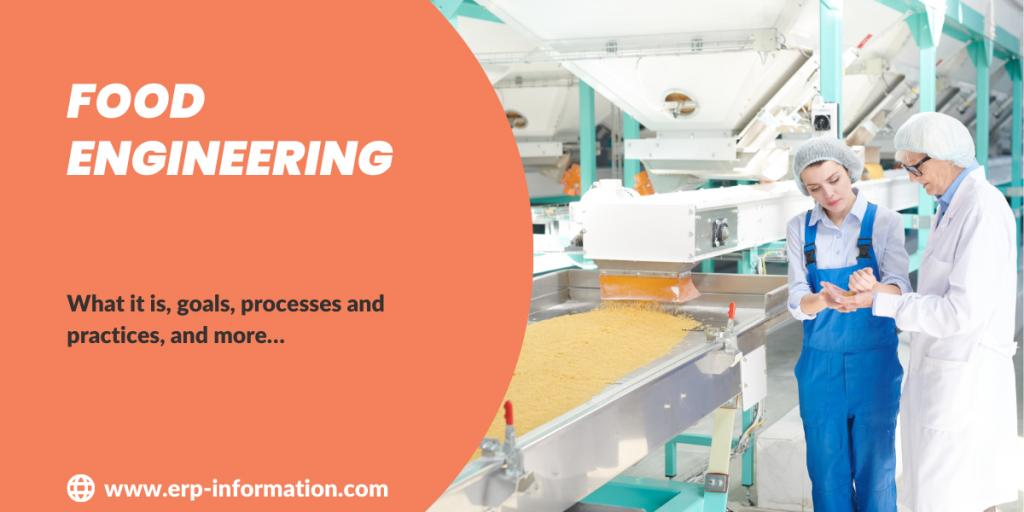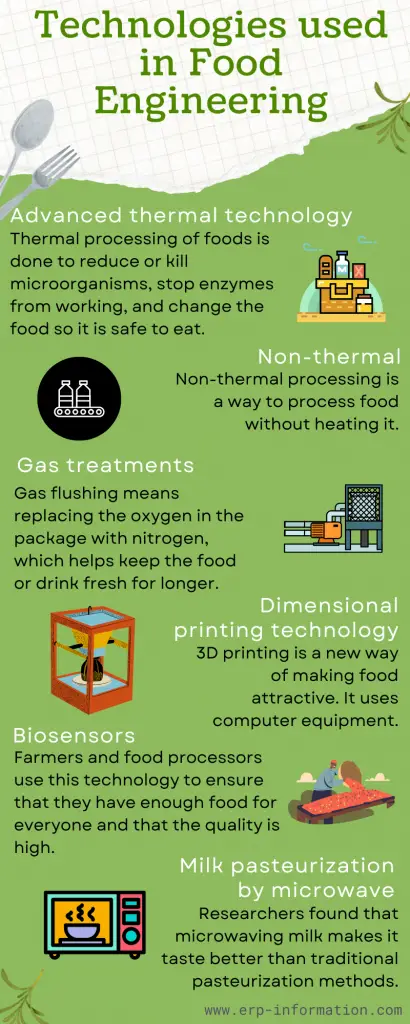Food engineering is an exciting field of science that combines the traditional areas of chemistry, microbiology, and biochemistry with other disciplines to develop novel processes and products to meet society’s food needs.
It encompasses developing innovative processes for production, packaging, distribution, quality control, safety assurance, and methods for creating healthy foods from raw ingredients.
In addition, a growing population creates an ever-increasing demand for food efficiency, sustainability, and diversity.
This blog post will provide a clear picture of food engineering, its goals, processes & practices, technologies, skills of a food engineer, and responsibilities.
What is food engineering?
Food engineering is a combination of science, math, and engineering used to make food. It includes processing, production, handling, storing, controlling, and packaging food products.
Food engineering uses many types of engineering, such as electrical, mechanical, and chemical. Therefore, it is a very complex field with lots of different parts.
Goals of food engineering
- It seeks to create more efficient processes that improve food products’ production, shelf-life, safety, nutritional value, and flavor while maintaining their quality.
- Applications include reformulating existing products to optimize yields or reduce costs.
- Increasing product shelf life through advanced technologies
- Controlling quality by measuring moisture content
- Developing new packaging materials or formats to extend product shelf life or alter the presentation
- Analyzing ergonomics of production systems for safe working conditions for personnel and more.
To achieve these objectives, food engineers use various techniques such as thermal processing, fermentation, separation technologies, packaging technology, product design and formulation, biotechnology, and modeling/simulation methods.
Processes and practices
Refrigerating and Freezing
Refrigerating and freezing food help keep it fresh and safe. It can help the food look, taste, and have the right nutrition. Freezing also helps slow down bacteria growth which could make people sick. This process is very helpful for preserving perishable foods.
Evaporation method
Evaporation is a process that can help food last longer. It is used to make the food more solid, change its color, and reduce how much water it has.
Evaporation is used when making milk, coffee, fruit juices, sauces, sugar, and oil. It can also dry out vegetables, fruits, meats, and fish so they don’t spoil.
Food packaging
Food packaging technologies help keep food fresh and safe. For example, they can use cans and jars for packaging food.
In addition, companies are trying to use eco-friendly packaging, which is better for the environment. This also helps them get more customers who care about the environment.
Energy for sustainability
To improve food processing for the environment, you need to use energy efficiently and capture heat from machines. You can also replace old machines with new ones that use less energy, save money, and are better for the environment.
Heat transfer to maintain the quality of food
Heat transfer is very important in making food products. It helps keep the food healthy and tasty. Heat transfer methods include induction, convection, and radiation. These tools help engineers make new foods by freezing, baking, deep frying, or using infrared radiation.
Food Safety Management System(FSMS)
FSMS is a way to ensure food is safe for people. In a few countries, it is required by law that food production businesses use and maintain this system.
The system looks at possible dangers in the food supply chain, like bacteria or chemicals, and tries to control them so the food can be safe. The ISO 22000 standard tells businesses what they must do to ensure their FSMS works properly.
Technologies used in food engineering
Advanced thermal technology
Thermal processing of foods is done to reduce or kill microorganisms, stop enzymes from working, and change the food so it is safe to eat. Examples include making starch jelly-like and changing proteins.
Sometimes heat is used to make food safe for us to eat. It helps the food last longer and stops bacteria or germs from getting in. Heat can sometimes change the flavor or texture of food too.
Non-thermal technologies
Non-thermal processing is a way to process food without heating it. This means that no nutrients will be lost, unlike thermal processing, where heat can damage some of the nutritious materials in food.
Gas treatments
Food and drinks use gas flushing to stop them from going bad. Gas flushing means replacing the oxygen in the package with nitrogen, which helps keep the food or drink fresh for longer.
Dimensional printing technology
3D printing is a new way of making food attractive. It uses computer equipment. It can be used to make food layers. 3D printing is usually slow but gets faster and cheaper over time. Ex: chocolate, cake, pizza, etc
Biosensors
Biosensors help people make sure their food is safe. They can be used in labs and during different stages of food processing. Farmers and food processors use this technology to ensure that they have enough food for everyone and that the quality is high.
Biosensors can track and analyze the quality of the food during many parts of its journey – like when it’s made, shipped, and sold. This helps people stay safe from illnesses caused by bacteria or viruses in their food.
Milk pasteurization by microwave
When the temperature of the milk is controlled, it tastes better. But if it’s not stored properly, bad things can happen to the flavor and safety of the milk.
People developed pasteurization processes to help keep it fresh and safe for longer. Researchers found that microwaving milk makes it taste better than traditional pasteurization methods.
Who are food engineers?
Food engineers are people who determine how to make, process, deliver, and store food and farming products. In addition, they work on making the food safe to eat, creating medicines from plants, and finding ways to package things without hurting the environment.
Responsibilities of food engineers
- Take care of the food and agricultural products’ processes, packaging, and delivery.
- Design more environmentally friendly packaging.
- Adopt a combination of engineering, science, and marketing to come up with solutions for problems that can happen while making food.
- Responsible for developing new technology for processing and packaging
- Finding out a new way for better preservation of food items
- Sensible usage of food equipment
- Conduct in-depth research on new food development and pharmaceutical products.
- Provide technical and marketing support.
- Design the different equipment to meet specific expectations
- Evaluate the production process.
Types of food engineers
- Food Scientist
- Food Safety Engineer
- Quality Engineer
- Manufacturing Engineer
Skills of a food engineer
Food engineers should have good communication skills
As a food engineer, you should talk to others in the same field, like food technologists, technicians, and scientists.
Problem-solving skills
Food engineers should be able to solve problems related to food production, processing, and delivery. They need good listening, research, creative thinking, decision-making, and time management skills.
Analytical skills
Analytical skills help you look into complicated things and determine what to do next. Analytical thinking means looking at data or facts and understanding them better.
Business skill
Food engineers must have a business which includes knowing how to work with a team, talking to customers and getting them to agree with them, meeting new people and making relationships with them, finding out what other companies are doing in the same business, and telling people what your project is about.
Qualifications and available courses
Food engineers should have a degree in
- Bachelor’s degree in Food Science,
- Agricultural engineering,
- B.Tech food technology
- Chemical engineering
FAQS
What is food engineering, and how does it differentiate from traditional food science?
It is a specialized field within food science that applies engineering principles to the production, processing, and preservation of food. It sets itself apart from traditional food science by placing a greater emphasis on the technological and engineering aspects of food production.
What are the primary applications of food engineering in the food industry?
Food engineering finds wide-ranging applications in food processing, packaging, quality control, and safety measures. It plays a vital role in developing innovative food products, optimizing manufacturing processes, and ensuring the highest standards of food safety.
How does food engineering contribute to food preservation and extending the shelf life of products?
Food engineering employs various techniques such as pasteurization, canning, freezing, and refrigeration to preserve food and extend its shelf life. These methods effectively prevent spoilage, retain nutritional value, and ensure the overall quality of the food.
Why is food engineering important in tackling global challenges of food security and sustainability?
It aids in improving the efficiency of food production, reducing food waste, and promoting sustainable methods of food processing. By increasing productivity and reducing the environmental impact, It plays a substantial role in advancing worldwide objectives related to food security and sustainability.
Where do most food engineers work?
Most food engineers get a job in the food production business, agriculture equipment production companies, a business that produces food packaging materials, etc.
Write the difference between food technology /science and food engineering
Food engineering focuses on producing food and designing machinery and processes for large-scale manufacturing. Food technology is a stream of study covering all aspects of food, including physics, chemistry, biology, engineering, and technology.
Conclusion
In all, food engineering is a complex yet exciting field of work. Those who work in it must have an understanding of science and a real interest in the culinary arts, as they create not only safe foods but also delicious ones.
Food engineering is an important subject. It combines food science, chemistry, and engineering to make food better.
Food engineers help improve food production, safety, nutrition, and taste. This article gave more information about food engineering and what food engineers do.


